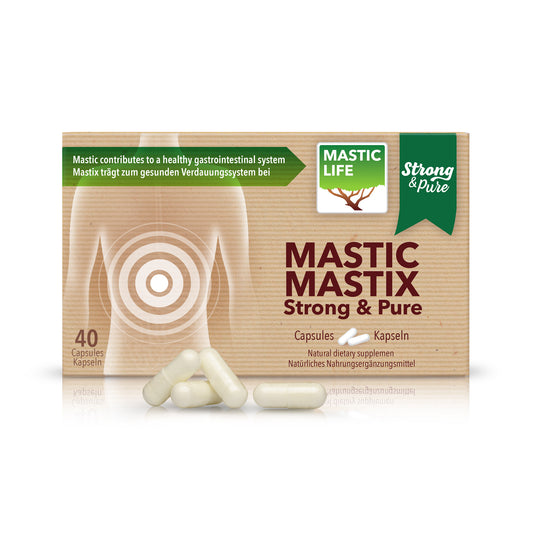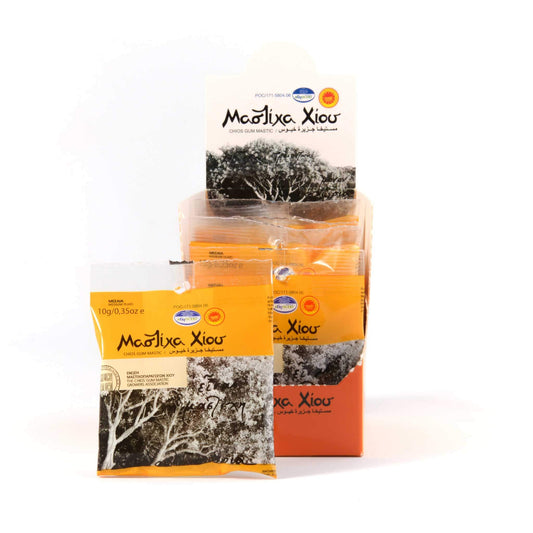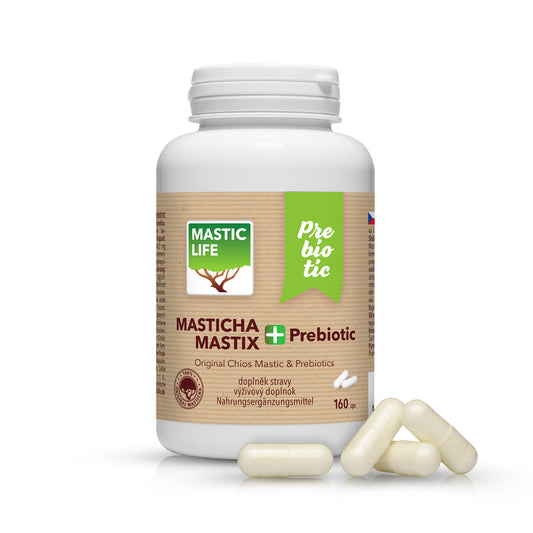Studies: ANTIDIABETIC ACTIVITY OF CHIOS MASTIC
Recent data emphasize on the indisputably positive effects of Chios Mastic on glucose metabolism. Precisely, researches have shown that Chios Mastic ameliorates hyperglycemia. Certain components of Chios Mastic are associated with this effect, such as oleanonic acid and important triterpenoid compounds such masticadienonic acid and isomasticadienonic acid. In vivo trials resulted in significant reductions in blood glucose, showing major antidiabetic activity. A large scale human clinical trial draw the conclusion that Chios Mastic reduces total cholesterol and glucose levels of healthy individuals, with outstanding tolerance.
ANTIDIABETIC ACTIVITY OF CHIOS MASTIC GUM
Study 1
Petersen et al (2011) conducted a research for more effective and safe antidiabetic substances, and therefore developed a pharmacophore model depending on partial agonists of PPARγ, which is the subtype γ of fatty acid activated transcription factors belonging to the thyroid/retinoid nuclear receptor family. Methyl oleanonate, a component found in Pistacia lentiscus var. chia oleoresin was selected. Oleanonic acid, the acid of methyl oleanonate, was identified as a PPARγ agonist analysis of Chios Mastic fractions. It is worth mentioning that other sub-fractions also demonstrated certain biological effects towards PPARγ 44.
Study 2
Vuorinen et al (2015) also conducted a pharmacophore-based virtual screening to filter a natural product database for possible 11β-hydroxysteroid dehydrogenase 1 inhibitors. The examination was specifically targeted on the triterpenoids of Pistacia species. For instance, masticadienonic acid and isomasticadienonic acid, which constitute major triterpenoid substances of Chios Mastic were found. Both the aforementioned acids selectively inhibited 11β-hydroxysteroid dehydrogenase 1 over 11β-hydroxysteroid dehydrogenase 2 at low levels. Thus, the results indicate that inhibition of 11β-hydroxysteroid dehydrogenase 1 contributes to the antidiabetic activity of the studied commodity 45.
Study 3
Georgiadis et al (2013), explored the activity of Chios Mastic on metabolic parameters of diabetic mice. Streptozotocin-induced diabetic 12-week-old male C57bl/6 mice were diverted to three groups, depending on the dose of the product and the duration of administration. After 4 weeks, the consumption of Chios Mastic led to reduced serum glucose and triglyceride levels in both low and high dose mastic groups. The body weight levels were decreased in the low dose mastic group, in comparison with the control groups. In the end, the low dose group demonstrated outstandingly lower serum glucose, cholesterol, low-density lipoprotein cholesterol and triglyceride levels and ameliorated high-density lipoprotein cholesterol levels. The high dose mastic group had ameliorated serum triglyceride levels. Hepatic steatosis was in part reversed in both low and high dose mastic groups. To summarize, low doses of Chios Mastic improve glucose and lipid disturbances in diabetic mice, and at the same time relieve hepatic damage 46.
Study 4
Saad Ur Rehman et al (2015) researched the anti-diabetic activity of crude Chios Mastic in alloxan-treated diabetic rats. Interestingly, Chios Mastic in the quantity of 100 mg/kg resulted in significant decrease in blood glucose. Therefore, it is indicated that crude Chios Mastic is effective in diabetes treatment, since it poses a remarkable antihyperglycemic activity by reducing serum glucose level in diabetic rats and by augmenting glucose tolerance in a large degree 47.
Study 5
Tzani et al (2016), investigated the role of Chios Mastic in metabolic profile and liver histology in an animal model of NAFLD. Administration of Chios Mastic at a dose of 20mg/Kg of body weight per day for 4 weeks resulted in lower glucose, triglyceride and interleukin-6 (IL-6) levels and on the same time hepatic steatosis was partially reversed 48.
Study 6
Triantafyllou et al (2006), studied the effects of Chios Mastic on metabolic and hepatic biochemical indices of human subjects. More specifically, male subjects receiving daily a Chios Mastic solution (low-dose group) for 12 months presented significantly lower glucose levels 49.
Study 7
Kartalis et al (2015) studied the effects of Chios Mastic on 156 healthy individuals with regards to cholesterol and fasting plasma glucose (FPG) levels, for a total period of eight weeks. The volunteers were divided into 3 groups; the control group ingesting placebo, the total Mastic group receiving 1 g of crude Chios Mastic daily (330 mg capsules, tid), the polymer-free Mastic group taking 1g of polymer free Chios Mastic daily (330mg caps, tid), and the powder Mastic group receiving 2g of crude Chios Mastic per day. As a result, in the total Mastic group total cholesterol was decreased by 11.5mg/dl and FPG by 4.5mg/dl taking into account the age, gender, BMI and baseline properties. Overweight and obese subjects (BMI>25) showed a stronger effect and the estimated mean decrease of total cholesterol was 13.5mg/dl (p<0.05) and of FPG 5.1mg/dl (p<0.05). Interestingly, there were no side effects in the gastrointestinal, liver or renal system. Hence, Chios Mastic presents an essential reducing activity on total cholesterol and glucose levels of healthy individuals, with exceptional tolerance and no detectable adverse events 50.
Study 8
Fukazawa et al (2017), studied the effect of Chios Mastic on healthy Japanese men. In particular, daily intake of 5g of Chios Mastic powder reduced triglyceride levels at 3 months and insulin and HOMA-IR values at 6 months. Chios Mastic intake combined with exercise reduced triglyceride levels at 3 months and HOMA-IR values at 3 and 6 months 51.
Study 9
Georgiadis et al (2014) examined the biological mechanisms that could explain traditional usage and recent pharmacological findings. More specifically, the author and the co- authors conducted a review of a relevant scientific literature database regarding studies on Chios Mastic and on natural products demonstrating peroxisome proliferator-activated receptor (PPAR) agonist activity, and they explored Chios Mastic as a PPAR modulator. Chios Mastic chemical composition has been extensively examined and the presence of various substaces, particularly triterpenoids is well established. Precisely, oleanonic acid, oleanolic acid and gallic acid are known to act as PPAR modulators. Conclusively, it is suggested that some compounds of Chios Mastic on PPARs act synergistically, and more specifically on both PPARs isotypes -α and -γ, which may comprise one of the more essential biological mechanisms via which the commodity exerts its manifold actions 52

----------------------------------------------------------------------------------------------
- Petersen R.K., Christensen K.B., Assimopoulou A.N., Fretté X., Papageorgiou V.P., Kristiansen K., Kouskoumvekaki I. [2011]: Pharmacophore-driven identification of PPARγ agonists from natural sources. J. Comput. Aided Mol. Des., 25 (2): 107-16.
- Vuorinen A., Seibert J., Papageorgiou V.P., Rollinger J.M., Odermatt A., Schuster D., Assimopoulou A.N. [2015]: Pistacia lentiscus oleoresin: Virtual screening and identification of masticadienonic and isomasticadienonic acids as inhibitors of 11β-hydroxysteroid dehydrogenase 1. Planta Med., 81 (6):525- 532.
- Georgiadis I., Karatzas T, Korou L.-M., Agrogiannis G., Vlachos I.S., Pantopoulou A., Tzanetakou I.P., Katsilambros N., Perrea D.N. [2013]: Evaluation of chios mastic gum on lipid and glucose metabolism in diabetic mice. J Med Food, 00 (0): 1–7.
- Saad Ur Rehman M., Hafeez Kamran S., Ahmad M., Akhtar U. [2015]: Anti-diabetic activity of crude Pistacia lentiscus in alloxan-induced diabetes in rats. Bangladesh J of Pharm, 10 (3):543-547.
- Tzani A, Georgiadis, I, Korou LM, Konstantopoulos P, Agrogiannis G, Vlachos I, Doulamis I, Katsilambros N, Perrea D. (2016). Investigation of chios mastic gum effect on metabolic profile in streptozotocin-induced diabetic mice. Atherosclerosis.
- Triantafyllou A, Chaviaras N, Sergentanis TN, Protopapa E, Tsaknis J: Chios mastic gum modulates biochemical parameters in a human population. J Ethnopharmacol 2007; 111: 43-9.
- Kartalis A., Didagelos M., Georgiadis I., Benetos G., Smyrnioudis N., Marmaras H., Voutas P., Zotika C, Garoufalis S., Andrikopoulos G. [2015]: Effects of Chios mastic gum on cholesterol and glucose levels of healthy volunteers: A prospective, randomized, placebo-controlled, pilot study (Chios-Mastic). eur J of Prev Cardiol, epub ahead of print.
- Fukazawa T, Smyrnioudis I, Konishi M, Takahashi M, Ki K Hyeon, Nishimaki M, Xiang M, Sakamoto S. (2018). Effects of Chios mastic gum and exercise on physical characteristics, blood lipid markers, insulin resistance, and hepatic function in healthy Japanese men. Food Science and Biotechnology.
- Georgiadis I., Karatzas T, Korou L.-M., Katsilambros N., Perrea D. [2014]: Beneficial health effects of chios gum mastic and peroxisome proliferator-activated receptors: Indications of common mechanisms. J Med Food, 00 (0): 1–10.
Mastic for your gastrointestinal tract
-
Mastic Strong&Pure Economy Pack (240 Capsules) Masticlife
Regular price 341,00 zł PLNRegular priceUnit price / per364,00 zł PLNSale price 341,00 zł PLNSale -
Mastic Strong&Pure (40 Capsules) Masticlife
Regular price 66,00 zł PLNRegular priceUnit price / per -
Mastic Chios Raw Tears Medium Size 10 x 10 g
Regular price 147,00 zł PLNRegular priceUnit price / per -
Mastic+ Prebiotic (160 Capsules) Masticlife
Regular price 179,00 zł PLNRegular priceUnit price / per




